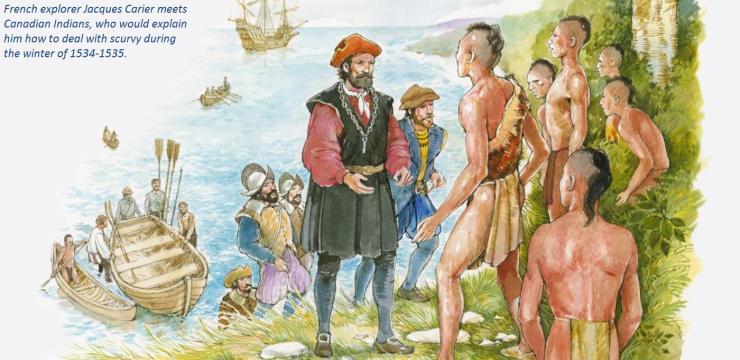
- The gist of this article
In the Oscar winning film The Revenant, the life of the main character is saved when an Indian wraps him in a poultice of bark stripped from a pine tree. They didn’t know it in the 19th century, but the secret healer was the OPCs later identified and extracted by Professor Jack Masquelier.
Exploring the benefits of OPCs
Native Indians had known about the healing properties of pine bark for hundreds of years. And this wasn't the first time they had used their knowledge to save the lives of westerners.
In the mid-16th century, the French explorer Jacques Cartier became trapped when the St Lawrence River in Canada froze over. Cartier’s logbook records the horrific decay and death of many of his crew over the course of the winter. They were dying from an extreme form of scurvy.
Scurvy is a condition that causes our body’s vascular and lymphatic system to collapse due to a prolonged lack of Vitamin C from fresh fruit and vegetables. This leads to excessive bleeding, edema in the legs. It also causes our teeth to fall out and our eyesight to fail. Of course, at the time it was not known that the illness then known to sailors as the big one’ was caused by a lack of Vitamin C.
Just as the situation seemed hopeless, Cartier noticed that an Indian with whom he traded showed signs of scurvy, only to recover and look perfectly healthy. The Indian revealed the secret – a tree called Anneda – and showed Cartier how to concoct a drink from its bark and needles. The solid leftovers, meanwhile, were to be placed on afflicted body parts as a poultice.
Cartier’s men drank the tea and recovered within a few days. And the open wounds treated by the poultice were soon healed.
Jack Masquelier and the discover of OPCs in pine bark
Cartier thanked God for the intervention. But the fact is that The Revenant (based on a true story) and Cartier’s expedition provide early evidence of the powerful antioxidant protection provided by OPCs found in the pine bark, combined with Vitamin C from the pine needles.
It was another 400 years before OPCs were discovered and explained – by Professor Jack Masquelier in the 1950s. Maqueliers OPCs are proven to promote effective microcirculation by maintaining the integrity and function of the countless tiny capillaries through which nutrients are delivered to all our cells and organs. A healthy microcirculation system also helps ensure waste material and CO2 flow harmlessly out of our bloodstream and bodies.
OPCs and vitamin C – a powerful combination
As we have seen, it was the Vitamin C in the pine needless that cured the scurvy experienced by Cartier and his men. And today we all know that the Vitamin C we need is easily obtained from fresh fruit and vegetables. But what many people do not know is that Masquelier and other scientists have demonstrated that Vitamin C is more effectively absorbed into our bodies when taken with OPCs, which act as a‘cofactor’.
This is particularly relevant at a time when so much of the food we eat is cooked, peeled and processed, thereby removing the natural OPCs that occur in, the seeds of grapes or the skin of fruit and vegetables.
And although nobody today experiences scurvy as it was suffered by sailors until the 19th century, many people experience leg and eye related vascular problems, especially as they get older. These problems are, in a sense, 21st century symptoms of scurvy.
Easing heavy legs
Indeed, the first OPC product to be available on the market – a product called Resivit sold in France – was used largely by women who suffered from ‘heavy legs’ and other leg-related vascular problems such as varicose veins. Tests in the 1980s confirmed that a daily dosage of OPCs increased venous efficiency and significantly eased symptoms such as heavy legs.
Improving eyesight
The eyes, meanwhile, are particularly subject to vascular degeneration because the vascular system in the eye is not embedded in muscular fibers. Once the main artery has entered the eye, it gradually loses its elastic outer coating and muscular fibers. This makes it difficult to ‘nourish’ the eye and our eyesight invariably degenerates as we age. Moreover, eyes today are affected by the length of time we spend staring computer and TV screens.
OPCs protect the vascular system that nourishes our eyes, and limit the effects of excessive strain and the consequences of too much or too little light. A study conducted in France in the 1980s demonstrated that the eyesight of 98 out of 100 people was improved by a daily dose of OPCs.






